
Patrick Hand Original Planter's Hat Menu: 1 2 3 4 <<First
The Patrick Hand Original™ Planter's Hat, Page 4
Cocked Hats During the Golden Age of Piracy
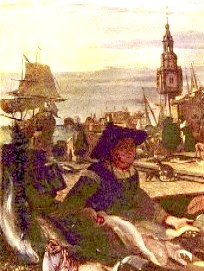
Artist: Emanuel de Witte
A Hat Cocked in Front from
Markt am Hafen (1680)
The fascinating part of the story of my research into hats during the golden age of piracy concerns the cocked hat (and its ultimate product, what we now call the tricorn.)
The cocked hat is the natural evolution of a broad-brimmed hat. As Michael Harrison states, "with the dawn of the 17th century, the wide-brimmed hat is back again and so, inevitably, is the 'cock.'"1 Cocked hats allowed the broad-brim hat to survive well into the golden age of piracy and beyond.
John Repton agrees with Harrison, noting that "from the inconvenience of the broad-brim, one flap was made to lift up, and was placed either in front, or the back of the head; and about the same time we begin to perceive two flaps turned up, when about the reign of Queen Anne [1702-1707] the third flap was introduced, which formed the complete cocked hat."2
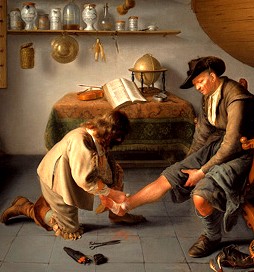
Artist: Isaack Koedijck
Surgeon Tending the Foot of a Man in a Hat Cocked
to the Side, from
Un chirurgien barbier soigne le
pied d'u paysan (1649-50)
Madeline Ginsburg explains that "the brim grew wider [during the reign of Charles II] and since it tended to droop when unsecured, cocking it, or turning it up, became the custom, and it was sometimes held in place with a loop or button."3
As a result, it became fashionable to cock one or two sides of one's hat, although like today's fashion, it was not to everyone's taste. While waiting (somewhat impatiently) in the Treasury-chamber at White Hall on June 3rd, 1667, Samuel Pepy's notes in this diary that one of the accountants was "a brisk young fellow, with his hat cocked like a fool behind, as the present fashion among the blades is"4.
While the accountant's hat cock incensed him, Pepys apparently didn't mind the style on women (or at least one particular woman). Four years earlier he explained that "Mrs. [Frances] Stewart in this dress, with her hat cocked and a red plume, with her sweet eye, little Roman nose, and excellent taille, is now the greatest beauty I ever saw, I think, in my life"5. Perhaps his comments had less to do with her cocked hat and more to do with her nose and "excellent taille." But I digress...
Ginsburg
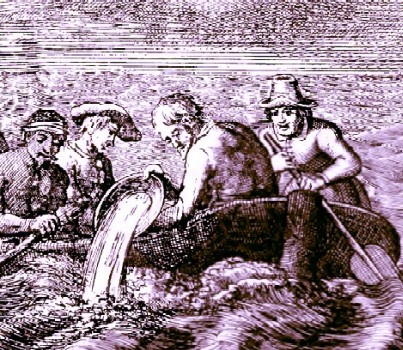
A Front and Side Cocked Hat at Sea, from Zeer aanmerkelijke reysen gedaan
door Jan Erasmus Reining, by Dionysius van der Sterre (1691)
says that rear-cocked hat that Pepys objected to became known as the Monmouth cock, "called for the Duke of Monmouth, the natural son of Charles II and unsuccessful contender for the throne in 1689."5 She mentions another style of hat cocking which you will see in some of these images: that of turning up the front. Ginsburg suggests that this may have been referred to as the Ramillies cock, "which took its name from the battle of Ramilles in 1706 when the Duke of Marlborough routed the French and their allies."7
While cocking a hat was clearly fashionable in the latter half of the 17th century, there is little apparent pattern to the trends, which vascillated between cocking one side or another, the front and the back and various combinations thereof.
Michael Harrison explains that although "the 'cock' is a great deal more ancient than the 18th century; it was that century's genius to regulate and formalize the 'cock' – that is all. Again and again the 'cock' appears in the history of the hat, mostly for the reasons that, short of stiffening the brim of a wide-brimmed hat until the felt is as stiff as wood, a 'cock' is inevitable, to counteract the inevitable droop of the brim."8
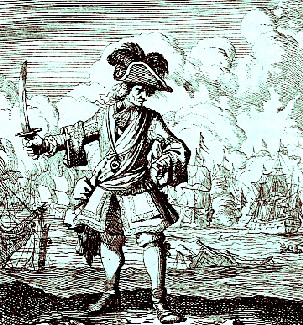
Artist: Christoph Weigel
An admiral from Caspar Luken's Standebuch (1689)
Cocking a hat became a prevelant style in society during the golden age of piracy. A couple of different articles in the social commentary periodical The Spectator attest to this. A woman writing to the magazine on December 19th, 1711 suggests that "men in all ages would be found to have been little less whimsical in adorning that part [the head] than ourselves. The different forms of their wigs, together with the various cocks of their hats, all flatter us in this opinion."9
In another article in The Spectator, a hatter in London wrote a tongue-in-cheek letter addressing the various types of cocked hats men wore. He explained that he was at that time making "hats for the several kinds of heads that make figures in the realms of Great Britain, with cocks significant of their powers and faculties.... His hats for men of the faculties of law and physic [medicine] do but just turn up, to give a little live to their sagacity; his military hats glare full in the face;
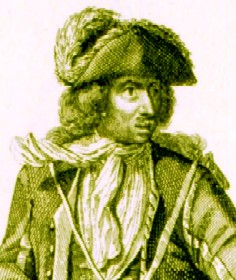
Artist: Caspar Luken
Englischer Admiral Full from "Neu-eröffnete
Welt-
Galleria, Taken from The
Herzog
August
Bibliothek
Wolfenbuttel Collection (1703)
and he has prepared a familiar easy cock for all good companions between the above-mentioned extremes."10
This clearly establishes cocked hats among the cognosciente in London. Whether the cocked style of hat made its way from the world of fashion to the world of the sailor during the golden age of piracy cannnot be completely proven, however. Based on several period images, officers almost certainly wore cocked hats, as befit their station in life. By way of example, see the 1721 image from Britannia americana of Beschryving der Engelsche colonien in West-Indien at the top of this page.
We also see such cocked hats on officers in some of Christoph Weigel's artwork from the period. He particularly placed a hat cocked front and back on the head of his English officer in the 1703 book Herzog August Bibliothek Wolfenbuttel.
But what of the common sailor?
1 Micheal Harrison,The History of the Hat , p. 119; 2 John Adey Repton, "Observations on the various Fashions of Hats", Archaeologia: or, Miscellaneous Tracts Relating to Antiquity. Vol. 24, p. 185; 3 Madeline Ginsburg, The Hat Trends and Traditions, p. 50; 4 Samuel Pepys, The Diary of Samuel Pepys, June 3rd, 1667 entry;5 Pepys, July 13tj, 1663 entry; 5 Ginsburg, ibid. 7 Ginsburg, p 50-1. 8 Harrison, p. 118; 9 Dorinda, The Spectator: no. 252-321; Dec. 19, 1711-Mar. 8, 1712, by Joseph Addison & Sir Richard Steele, No. 319, Thursday, March 6, 1711, p. 357; 10 John Sly, The Spectator: no. 474-555; Sept. 3, 1712-Dec. 6, 1712by Joseph Addison & Sir Richard Steele, No. 526, Monday, November 3, 1712, p. 259
Common Sailor's Headgear from Period Artwork
David Fictum
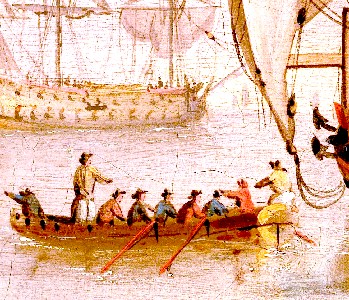
Artist: Peter Monamy
A Variety of Broad-brim Hats, From Shipping
in a Calm (1710-1725)
argues that the cocked hat - particularly the three-sided cock that is often identified with pirates - would not have been the prevalent head wear among them. While the three-sided cocked hats were making their way into the fashion world, they are rarely seen on artwork featuring regular sailors. Yet, "plenty of other hats are obviously some kind of simple felt hat/round hat" are found.1
As has already been mentioned, artwork is not considered primary source material because the accuracy of the image can be influenced by the artist's view, country of origin, intent in drawing, and even his ability to draw certain items.
Don Maitz, a modern pirate artist and designer of the original Captain Morgan (of rum fame) is reported
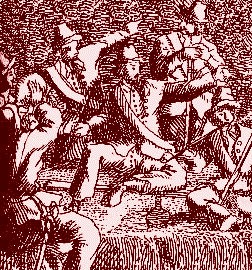
Edward Lowe's Men Drinking From
The Dutch Edition of the General
History of the Pirates (1725)
to have said that "a tricorne hat is one of the most difficult things to draw and have it come out looking right."2
In fact, when you study some of the images that feature cocked hats, particularly in woodcuts, it can be difficult to tell how a hat is cocked, or even if it is cocked at all! So if we are to arrive at any reasonable conclusion, we must tread carefully, observe closely and try to find an established trend in the artwork of several artists that indicates the style of hats worn by sailors.
A great deal
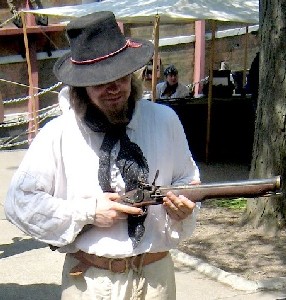
Photo: Mission
Thomas Alleman in a Hat Similar to Those
Worn by Lowe's Men, Columbus, May, 2012
of the period art showing scenes of sea life is by Dutch artists. Mr. Fictum points out that "if a Dutch artist ever saw sailors, he not only saw Dutch sailors, but also English ones as well (the maritime community was a close-knit one which often saw some English sailors working for Dutch ships and some Dutch sailors working for English ships)."3
While
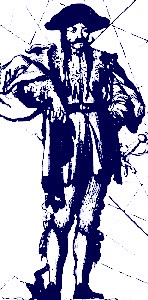
Artist: Joan van Keulen
Pas kaart van de noord kust
van espaniola (1684)
the English sailors worked with the Dutch, Michael Harrison notes, "The English [soldiers – in the very late 17th century] made it quite clear that they would tolerate the Dutch only if they could not possibly be mistaken for them."4 The fact that Defoe's 1725 book (cited on the previous page) suggests Monmouth caps were primarily used by Dutch sailors hints that this attitude may have existed among sailors as well.5
Since the majority of the daily scenes from this era are Dutch, however, we must hope that the artists captured the headgear of the English sailors who worked with the Dutch accurately. We have already seen a variety of Dutch etchings and paintings on this page, but here a few others showing a variety of hats on pirates and sailors from Dutch engravings for period books.
It is notable that while some cocked hats are shown, it is very difficult to determine if they cocked on all three sides in the tricorn fashion in most of these prints. Many of them are from woodcuts such as the gentleman in the image at right taken from a map. As this image shows, the medium often makes it difficult to discern how a hat is cocked.
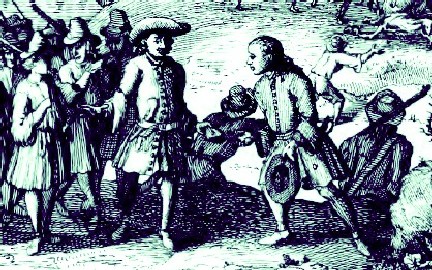 A Variety of Hats (Cocked and Not) on Pirates, from Zeer aanmerkelijke reysen gedaan door Jan Erasmus Reining, by Dionysius van der Sterre (1691) |
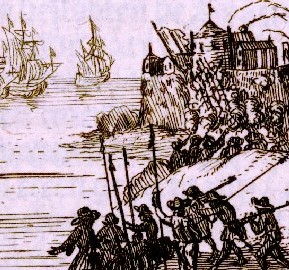 More Hats on Attacking Pirates from Zeer More Hats on Attacking Pirates from Zeer aanmerkelijke reysen gedaan door Jan Erasmus Reining (1691) |
 Artist: Abraham Storck Shipping off Amsterdam Detail 1 (Late 17th c.) |
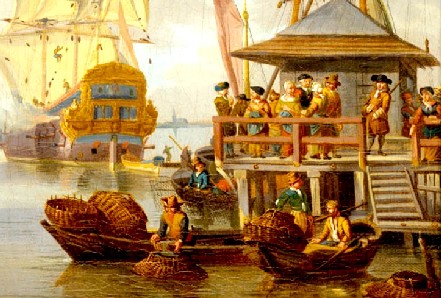 Artist: Abraham Storck Hats seen in Shipping off Amsterdam Detail 2 (Late 17th c.) |
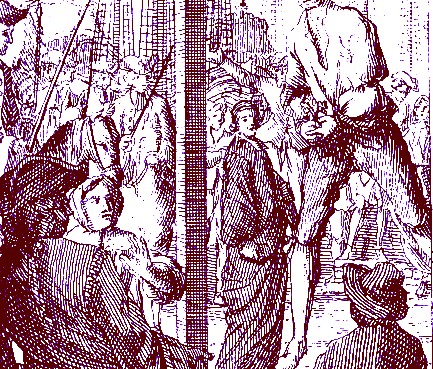
Several Cocked Hats, Including What Appear to Be Tricorns,
Detail from the image Majoor Stede Bonnet Gehangen(1725)
One print, taken from the Dutch version of the General History of the Pirates (Historie der Engelsche Zee-roovers) published in 1725 shows a crowd of people in Charleston, South Carolina watching the hanging of Stede Bonnet. Visible in the crowd are several men wearing what appear to be tricorn-style cocked hats. (Several of the men seen to the left of the gibbet pole in the image.)
These may or may not seamen, so this does neither proves nor disproves the use of tricorn-style cocked hats by sailors. In addition, this scene takes place on land and not at sea, where fashion likely had more sway.
A variety of hats also crop up amongst the sailing sorts in Christoph Weigel's engravings for German books from the golden age of piracy. The last image of the Dutch sailor appears to have his hat cocked on the side, but we are again limited by the medium. (Interestingly, although this image appears to be a new work, the posture and content closely resembles Weigel's other (possibly German) sailor drawn four years earlier.
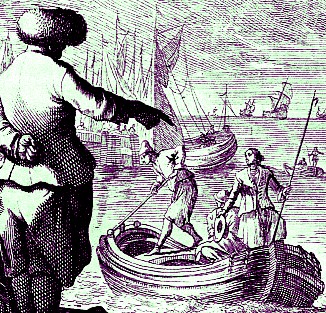 Artist: Christoph Weigel A Captain Giving Orders to Sailors in Port, from Ständebuch. (1689) (Note the variety of different hats shown.) |
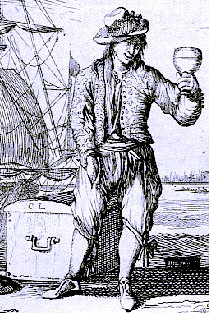 Artist: Christoph Weigel A Sailor in a Rather Disreputable Looking Hat from Ständebuch (1689) |
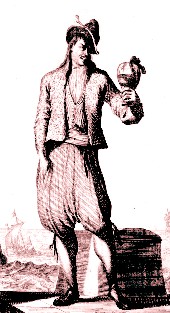 Artist: Christoph Weigel Dutch Sailor from Herzog August Bibliothek Wolfenbuttel (1703) |
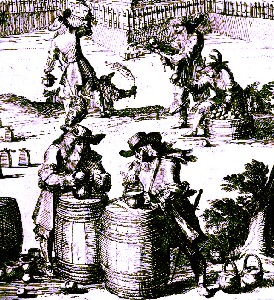
Artist: Christoph Weigel
Cocked Hats on French Grenadiers, From
Les Travaux de Mars, by Alain Manesson Malle,
p. 135 (1684)
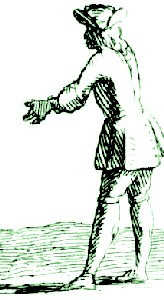
Portuguese Manm Martinique,
from Relation d'un voyage fait
en 1695, 1696 et 1697.
by Francois Froger (1700)
Work by French artists also show cocked hats on sailors, including what is the most promising example of a three-sided cocked hat seen in the image at right. It is again not clear that this is a sailor, so we may again be looking at fashion on land.
There is a watercolor image showing a cocked hat that can be seen on Gentleman of Fortune's Sailor's Footware Page from the Journal of a French Hydrographer named Duplessis who was traveling with Jacques Beauchesne in South America. It is again not entirely clear form the image whether the hat is cocked tricorn-like or not, although it certainly could be.
English artists
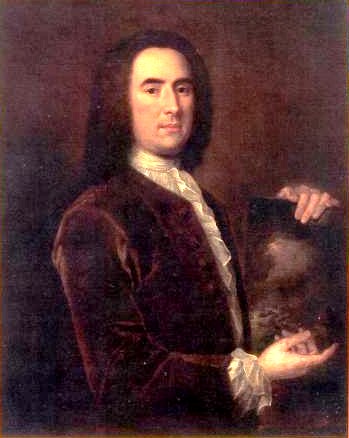
Artist: Thomas Stubley - Peter Monomy (1730)
from this period primarily focused on portraits and miniatures (usually of stylish customers who could afford to have their portraits done). The most notable works of regular men at sea at this time come from artist Peter Monamy.
Monamy was an English marine painter who lived between 1681 and 1749. He was bound as an apprentice to a Painter-Stainer, or what would today be called an interior decorator. This job included providing paintings, murals and signs for businesses.
Monamy was freed from his apprenticeship in 1704 upon the death of his master. "[I]t can reasonably be surmised that Monamy set up in business on his own account, both as a decorator and easel painter, quite soon after being made free in 1704."6 In the 1720s, Monamy's career took off. He became known for his marine works, producing five of them for George Byng, 1st Viscount Torrington and First Lord of the Admiralty from 17277.
Monamy's works often show naval battles and ships from afar, but some of them do show regular sailors in a variety of working environments, usually wearing hats. None of his sailors have tricorn-style cocked hats, most of the hats having a flat brim from the few paintings where this is discernable.
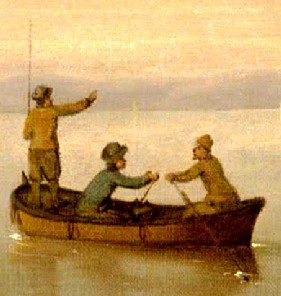 Artist: Peter Monamy Royal Yacht Becalmed at Harbor (1710-1730) |
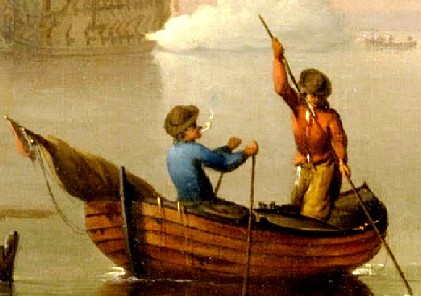 Artist: Peter Monamy Hats on Sailors, Detail from Royal Yacht Becalmed at Harbor (1710-1730) |
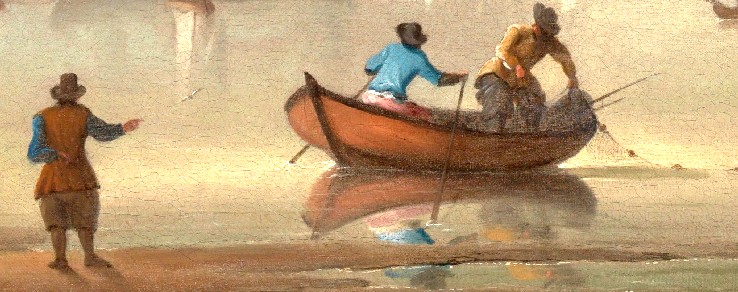 Artist: Peter Monamy - Hats on Sailors Detail from An English Royal Yacht Standing Offshore in a Calm (1730) |
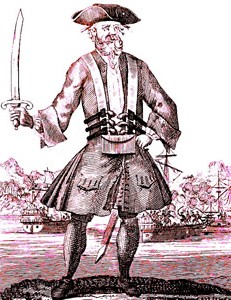
Artist: Benjamin Cole
Blackbeard (1724)
This brief review of period artwork may leave you scratching your head, wondering how tricorns came to be associated with pirates. The answer to this is quite simple. The images of the various pirate captains in the woodcuts from the early English editions of the General History of the Pirates show them - almost to a man - in the traditional three-sided cocked hat.
Historian David Fictum suggests that these images "tended towards depicting only pirate captains [not their men] and dressing them more like gentlemen captains (except for the women pirates). Gentlemen wore cocked hats."8
Writing a century and a half earlier, historian John Adey Reption agreed, explaining that "The Cocked hat in the middle of the last [18th] century was considered as a mark of gentility, and as a distinction from the lower orders, who wore round hats."9
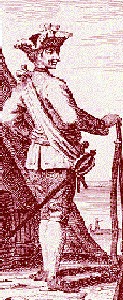 Artist: Joseph NIcholls George Lowther (1736) |
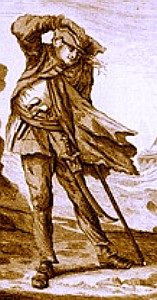 Artist: Joseph NIcholls Edward Low (1736) |
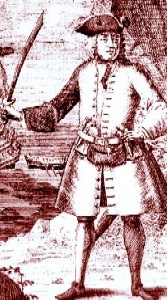 Artist: Unknown Henry Every (1734) |
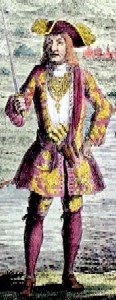 Artist: Benjamin Cole Bart. Roberts (1724) |
 Artist: Benjamin Cole Jack Rackham (1725) |
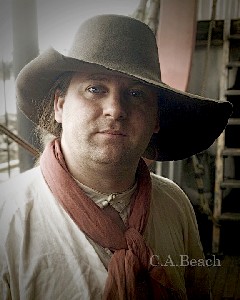
Photo: Clint Beach
Michael Bagley in a hat with a rolled
Brim in Columbus, May,
2012
The tricorn-style cocked hat was still worn by the upper class. It could be argued that when pirates captured ships with gentlemen on them, they may have taken these marks of class as a way of uplifting themselves or even making fun of the elite. The scene that Captain Evans of the Greyhound describes in the Charles Johnson's General History of the Pirates comes to mind. Here, the pirates "powdered themselves from head to foot, walked the decks with their hats under their arms, minced their oaths, and affected all the airs of a beau with an awkwardness that would have forced a smile from a cynic."10
However, the case against the three-sided cock is not entirely made. Noted pirate historian Ed Fox explains, "My own thought is that from the 1730s [after the golden age or piracy] we have lots of images of sailors in tricorns, but the key thing it they're worn 'backwards'. Almost all sailors for the next couple of decades are drawn with their tricorns backwards, and almost nobody else is - sometimes forwards, sometimes cocked to the side, but rarely backwards."11 Dr, Fox explains that this important because the backwards worn three-cock hat appears to have been prevalent primarily among sailors in the 1730s.
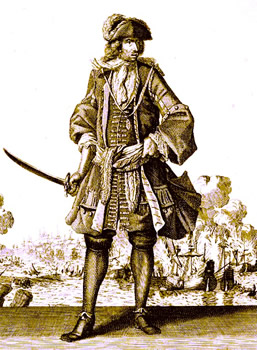
Artist: Caspar Luken
Englischer Admiral Full from "Neu-eröffnete Welt-
Galleria, Taken from The
Herzog
August
Bibliothek
Wolfenbuttel Collection (1703)
"The question is, 'did the fashion for a backwards tricorn on seamen spontaneously spring into existence fully-formed in 1735, or did it evolve and spread as fashions are wont to do?' The latter seems, on the face of it, more likely. In which case, the question becomes, 'when did the trend begin to develop?'"12 He then points to Christoph Weigel's 1703 image of an English Admiral (seen in close up in the previous section), noting that by his interpretation (of which he says he is fairly confident) the officer appears to be wearing a backwards facing tricorn. "I therefore posit the possibility of a growing fashion, possibly one which filtered from the top to the bottom, among Englishmen of the sea for wearing a backwards tricorn, beginning in the early 18th century and fully-established by the early 1730s."12
This is not conclusive proof, of course, which he [you] admits. So it is very possible that the tricorn-style cocked hat could be found on sailors and even pirates during the golden age of piracy. However, even Dr. Fox states that It wouldn't have occurred to the scale on which it is seen in many modern pirate movies. Based on the images from the period and the limits of the media, more sailors who wore cocked hats would have been likely to turn them up or even roll them in the ways that the sailors in the assortment of images here have done. And if they did wear a three-cock hat, it would most likely have been worn backwards.
1 David Fictum, email conversation, 6/6/14; 2 Cascabel, "some interesting pictures", Pyracy.com, April 23, 2012, gathered 6/10/13; 3 David Fictum, Discussion on hat, Authentic Pirate Living History group, May 23 at 2:19pm, gathered 6/6/14; 4Micheal Harrison,The History of the Hat , p. 131; 5 See Daniel Defoe, A tour through the whole island of Great Britain, Volume 2, Letter 6; 6,7 Peter Monomy, Wikipedia.com, gathered 6/6/1014; 8 David Fictum, Authentic Pirate Living History Group, facebook.com, May 23 at 2:19pm, gathered 6/6/14; 9 John Adey Repton, "Observations on the various Fashions of Hats", Archaeologia: or, Miscellaneous Tracts Relating to Antiquity. Vol. 24, p. 1864; 10 Attributed to Daniel Defoe, Manuel Schornhorn edition of the General History of the Pirates, page 69; 10 Ed Fox, Comments to a Discussion on Facebook group Authentic Pirate Living History on 12/15/16, Retrieved 12/5/16
Mission and the Patrick Hand Original™ Planter's Hat in Art
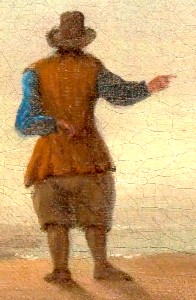
Artist: Peter Monomy
Many on Shore (1730)
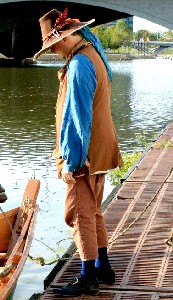
Photo: Dolphin Danie
Mission on Dock (9/2012)
Now, just in case you missed it in the above images, I wanted to point a detail from Peter Monamy's painting An English Royal Yacht Standing Offshore in a Calm, created in 1730. (The image appears at left.) The only way in which I have altered this image is to brighten it up a bit so that the details can be seen. (The original can be found here on wikimedia.)
Compare this gentleman's garb with my own, as seen at the Columbus Talk Like a Pirate Weekend on the Santa Maria in September of 2012.
There are some differences - the hat is a bit smaller of brim, the breeches are a bit shorter and the socks and shoes are a different color. Still, I feel pretty confident in stating that my garb and my hat are fairly well rendered for this period.

